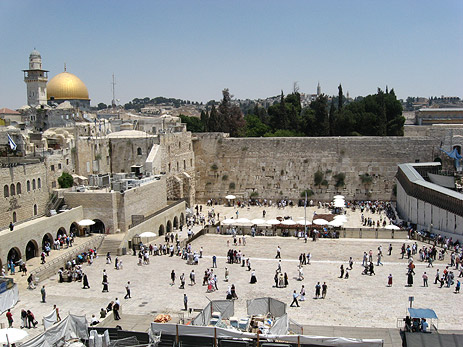Image Resource Bank
Image Gallery |  5 of 15
5 of 15 
The Wailing Wall (Western Wall), Jerusalem
Jerusalem is sacred to Judaism, Christianity, and Islam. It was the capital of the Israelite monarchy under King David, around 1000 BCE, and was the site of the First and Second Jewish Temples, where ancient Israelite sacrificial rituals were performed. The First Temple was destroyed in 587 BCE by the Babylonians. The Second Temple, built on the same site, was destroyed by the Romans following the Jewish uprising of 70 CE. Since then, Jews have revered the remaining foundation wall on one side of the former temple enclosure; pious Jews come to this so-called “Wailing Wall” to lament the destruction of the Second Temple and to pray, often placing pieces of paper containing special requests between the blocks of stone. For Christians, who consider Jesus to be the messiah foretold in the Hebrew Bible, Jerusalem is revered as the place where Jesus’ passion took place; the Church of the Holy Sepulchre marks the place where Jesus was buried before his resurrection. For Muslims, the Dome of the Rock (visible in the background), built on the temple mount, marks the place from which the prophet Muhammad made his miraculous ascent to heaven during his “night journey.”
Name: The Wailing Wall (Western Wall)
Material: Limestone
Size:
Length: 57 m (187 ft) (main, exposed wall); 487.7 m (1,600 ft) (total length of wall)
Height: 32m (105 ft) (total height from foundations); 18.9 m (62 ft) (exposed height); 45 stone courses, 28 exposed courses, 17 underground courses
Date: ca. 19 BCE, Second Temple period (1st half of wall); 7th century BCE (2nd half of wall)
Place of Origin: Old City Jerusalem, Israel
Location: Jerusalem, Israel
Registration # and Source: Wikimedia Commons. Link to resource![]() (accessed April 27, 2010).
(accessed April 27, 2010).
Attribution: Work up-loaded to Wikimedia Commons by Sustructu.
Material: Digital photograph
Size: 3,072 x 2,304 pixels (3.49 MB)
Date: 2008

 Fred M. Donner
Fred M. Donner
Professor of Near Eastern History, University of Chicago




